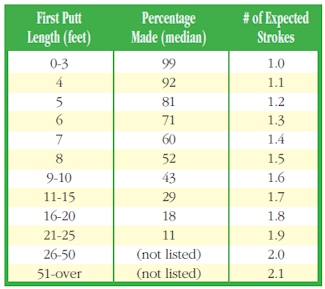Using Strokes Gained Putting to Analyze Flat Stick
 Traditional putting statistics such as average putts per round, average putts per green in regulation, and average number of one-putts and three-putts have always been available and easy to figure, but they never really answer the question of true putting ability. That’s because the number of putts taken during a round of golf largely
Traditional putting statistics such as average putts per round, average putts per green in regulation, and average number of one-putts and three-putts have always been available and easy to figure, but they never really answer the question of true putting ability. That’s because the number of putts taken during a round of golf largely
depends on the starting position of the first putt.
An article in Golf Magazine in the early 1980s attempted to address this issue. The author developed a formula where an expected stroke value was assigned to the distance of the fi rst putt on each hole. You would then compare the number of expected putts taken to the number of actual putts taken during a round of golf to determine how well you putted.
This article was far ahead of its time, for this is the very basis of the relatively new statistic called “strokes gained putting,” developed by Columbia University professor Mark Broadie. With the use of the PGA Tour’s ShotLink, a system of laser measuring devices employed at all tour events, Broadie was able to statistically measure, for the first time, true overall putting ability on the tour. The ShotLink database contains the information necessary for the statistic: firstputt length, percentage made, and average number of strokes to hole out from there. Adding up the average number of putts a touring professional would be expected to take from his starting positions over 18 holes and comparing it to the number of actual strokes taken – just like the Golf Magazine formula – is strokes gained putting. If a tour player takes fewer putts than expected, he is said to have gained strokes, and the number is figured with a “+” sign. If the number of putts taken is more than average, the player is said to have lost strokes, and the number is figured with a “-”sign. In this case, “+” is good and “-” is bad.
The formula is not rocket science. Anyone can use the data to figure out strokes gained putting, and here is how to do it.
The formula
In order to figure strokes gained putting, the first thing that must be done is to measure the length of the first putt a golfer has on the green. This can be done by estimation, but a better way is to walk off the putt. (Hopefully, the golfer has accurate steps.) Measure each putt to the nearest foot.
 Once we know the distance of the first putt to the nearest foot, we see how many strokes, to the nearest tenth, an average tour professional would take from that distance. We enter that figure, and the actual number of putts taken, on the scorecard for that particular hole. The chart is based on the 2013-14 PGA Tour season.
Once we know the distance of the first putt to the nearest foot, we see how many strokes, to the nearest tenth, an average tour professional would take from that distance. We enter that figure, and the actual number of putts taken, on the scorecard for that particular hole. The chart is based on the 2013-14 PGA Tour season.
As an example, suppose on the first hole your first putt is from 10 feet. A touring professional will make this putt approximately four out of 10 times, so the expected stroke average from here is 1.6. You write this number on the scorecard, along with the actual number of putts taken for the hole, in this case, say 1. On the second hole, your first putt is from 40 feet and you two-putt. On the third hole, you one-putt from 8 feet.
So far, your expected number of strokes is 5.1 (1.6 + 2.0 + 1.5). Since you’ve taken just four putts, you are said to be +1.1 strokes gained putting for the first three holes. We continue this for the entire 9- or 18-hole round. At the end of the round, compare the expected number of strokes to the actual number of putts taken, and you have strokes gained putting for that round.
Using the Data
As you can see, we can figure strokes gained putting for as little as one hole! Obviously, though, we want to take a much larger sample than that. Over the course of several rounds, we can see exactly where our players are excelling or lagging. If they are making only 20 percent of their putts from 8 feet, we can see they need work from this distance.
A word of caution: Remember, these numbers are based on how the best players in the world putt. If your players are minus in strokes gained putting, this is to be expected, since they are probably not professional players. If you are coaching those with professional aspirations, make sure they understand that half the players on tour are minus, too! Also, greens vary by difficulty, as flat greens are obviously easier to putt on than greatly undulating ones, and smooth greens are easier than bumpy ones. This system also does not take into account which way the putt breaks, which can also skew results.
Still, the formula should give coaches a good idea of how well their players putt, both overall and from various distances. A minimum of three rounds should be sufficient to provide both player and coach with accurate information




